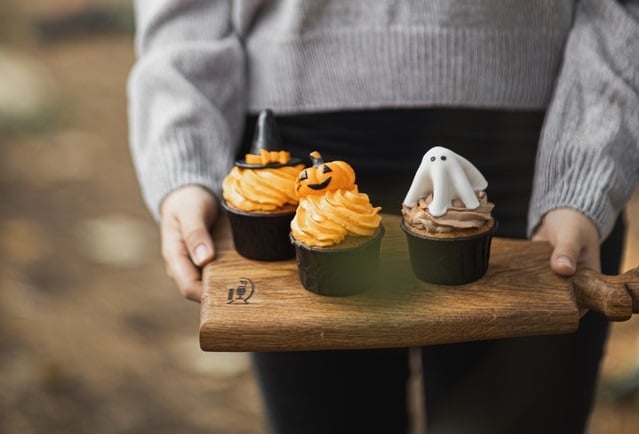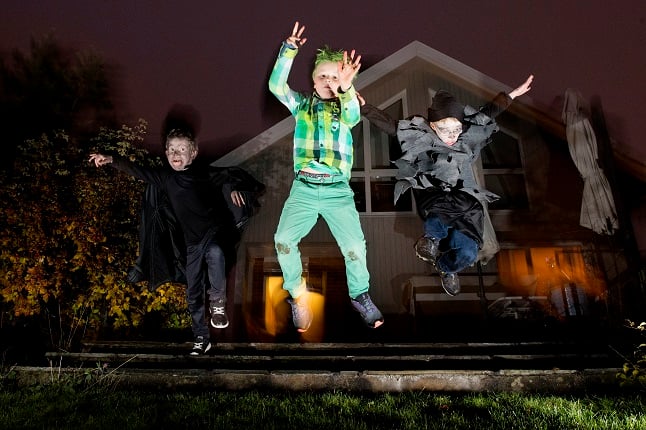Opinion: What can Sweden learn from embracing the American Halloween tradition?

Columnist Lisa Bjurwald was raised with a suspicion towards American commercialisation, but she's come round to the idea that Sweden could learn a thing or two from holidays like Halloween.
It’s that time of the year again: gather around the fire, ye natives Swedes, for our traditional cranky debate on imported holidays! This one won’t play out in the papers, and we’re far too polite to say it to your face. But trust me, it’s on.
"What is the ‘trick’ part of trick and treat, really?", a relative texted (I had sent out a warning that tiny ghouls might be circulating below her balcony come Saturday). "The Americans have already given the world Trump. Isn’t that a nasty enough trick?".
Ah, the Americans. If you’ve arrived here, say, in the last 20 years, it’s probably hard to fathom what a disdain many Swedes hold for all things US. But for many decades, the ruling Social Democratic Party painted a negative picture that’s still hard to rub out. In fact, amid many 40-somethings’ childhood memories of forest excursions and playing on the beach nests one of being placed high on a parents’ shoulders as mum and dad march down the street shouting slogans like "Crush American imperialism!".
But when it comes to holidays, there’s no doubt Americans got it right. Most of our own so-called Red Days are useless. Has there ever been a Kristi Himmelsfärd (Ascension Day) party in Sweden? Highly improbable.
You get to eat waffles on Marie Bebådelsedag (Feast of the Annunciation); perhaps a treat of unimaginable luxury to those born in the 1940s, but a standard feature at any half-decent Sunday brunch these days.
When I was a kid, in the 1980s and 90s, the dull Swedish Spring (here, April truly is the cruelest month) at least had Easter. The Christian connection was lost in secular Sweden, with celebrations instead consisting of decidedly unholy eat-til-you-feel-ill candy feasts in front of the video player.
But the Swedish autumn, when the rain doesn’t so much fall as whip you across the face, was just one endless wait for Christmas. It was completely devoid of highlights. The Swedish tradition of All Hallow’s Eve was and is mainly for grown-ups, a time for mourning and reflection marked by the placing of candles on lost ones’ graves. There’s no particular food or drink or anything else remotely cheerful about it.

Photo: Gabby K/Pexels
Then, in the mid- to late 90s, depending on where in the country you lived, an exciting foreign seed was planted. Monster masks and "slutty vampire" dresses started appearing not just in specialized costume stores but in mainstream shops. Clubs had DJ’s spraying the crowds with neon-pink cobwebs. Pumpkins, plastic spiders and fake fangs were suddenly stacked high by the supermarket cashier. Halloween had arrived! But trust the adults to try to spoil it.
Halloween was not just painted as silly and "imported" but as downright dangerous. Of particular concern were the monster masks, the topic of many a Principal’s Letter to the Parents. Supposedly, masks encouraged street crime. The sheer improbability of kids turning into robbers or murderers simply by placing a mask over their faces (although that would make a terrifying Halloween blockbuster) was rarely discussed.
The search term "Halloween" turns up only 3 results for the year 1990 in the Swedish media archive Retriever, but by 1995, the word is mentioned 45 times. Göteborgs-Posten comes across as suspicious:
"We seem to be about to embrace the Anglo-Saxon celebration of Halloween – All Saints’ Day, on October 31st. Commercially, Halloween is already a Swedish holiday to be reckoned with. The question is whether we, in the long run, will celebrate Halloween with the same fervor as Valborg or Lucia. ‘There is a need for a profane weekend during the autumn. Halloween may very well have a future in Sweden’, curator Ingeborg Borgenstierna at the Nordic Museum claims."
A Swedish elementary teacher based in the US is brought in to explain further: "[American kids] dress up as ghosts or witches and walk around knocking on doors, a bit like when Swedish children dress up as Easter witches, says Gunilla Engström."

Photo: Håkon Mosvold Larsen/Scanpix/TT
"Moderate Swedes are usually amazed at the amount of candy heaped at the children," the author writes. "They often gather entire bags of sweets, enough to last until Christmas. Alongside this idyllic celebration, teenagers, according to Gunilla Engström, are out ‘messing around,’ especially in the big cities."
As most children back then were only allowed a small amount of candy on Saturdays (lördagsgodis), perhaps it’s no wonder Halloween caught on with Swedish kids?
A scientist at Stockholm University’s Department of Ethnology, Ulla Brück, gets the final word: "This is about an Americanization, where the commercial power, combined with newspapers and television, is enormous."
But no amount of disdainful party poopers could stop the Halloween train. By the year 1999, Halloween had gone mainstream with a total of 379 mentions of the spooky holiday in the Swedish press and innumerable fake blood-soaked parties across the land. Now, there’s hardly a school or pre-school that doesn’t arrange a Halloween costume disco on Friday. Trick-or-treating has become a fun way for kids to meet their neighbours; a rare opportunity, at least in Swedish cities, where socializing usually extends to a quick "hello" in the communal stairs.
So thank God for the "vulgar Americanization". Not only has it lit up our calendar with the childish fun of Halloween and an explosion of heart-warming events on Valentine’s Day. It has also inspired us to create new, unquestionably Swedish holidays like Cinnamon Bun Day on October 4th.
All we need now is the successful export of our own, more solemn All Hallow’s Eve tradition, with hundreds of candle lights filling the graveyards after dark. Perhaps an Annual Cinnamon Bun Day is an easier sell…
Comments
See Also
It’s that time of the year again: gather around the fire, ye natives Swedes, for our traditional cranky debate on imported holidays! This one won’t play out in the papers, and we’re far too polite to say it to your face. But trust me, it’s on.
"What is the ‘trick’ part of trick and treat, really?", a relative texted (I had sent out a warning that tiny ghouls might be circulating below her balcony come Saturday). "The Americans have already given the world Trump. Isn’t that a nasty enough trick?".
Ah, the Americans. If you’ve arrived here, say, in the last 20 years, it’s probably hard to fathom what a disdain many Swedes hold for all things US. But for many decades, the ruling Social Democratic Party painted a negative picture that’s still hard to rub out. In fact, amid many 40-somethings’ childhood memories of forest excursions and playing on the beach nests one of being placed high on a parents’ shoulders as mum and dad march down the street shouting slogans like "Crush American imperialism!".
But when it comes to holidays, there’s no doubt Americans got it right. Most of our own so-called Red Days are useless. Has there ever been a Kristi Himmelsfärd (Ascension Day) party in Sweden? Highly improbable.
You get to eat waffles on Marie Bebådelsedag (Feast of the Annunciation); perhaps a treat of unimaginable luxury to those born in the 1940s, but a standard feature at any half-decent Sunday brunch these days.
When I was a kid, in the 1980s and 90s, the dull Swedish Spring (here, April truly is the cruelest month) at least had Easter. The Christian connection was lost in secular Sweden, with celebrations instead consisting of decidedly unholy eat-til-you-feel-ill candy feasts in front of the video player.
But the Swedish autumn, when the rain doesn’t so much fall as whip you across the face, was just one endless wait for Christmas. It was completely devoid of highlights. The Swedish tradition of All Hallow’s Eve was and is mainly for grown-ups, a time for mourning and reflection marked by the placing of candles on lost ones’ graves. There’s no particular food or drink or anything else remotely cheerful about it.

Photo: Gabby K/Pexels
Then, in the mid- to late 90s, depending on where in the country you lived, an exciting foreign seed was planted. Monster masks and "slutty vampire" dresses started appearing not just in specialized costume stores but in mainstream shops. Clubs had DJ’s spraying the crowds with neon-pink cobwebs. Pumpkins, plastic spiders and fake fangs were suddenly stacked high by the supermarket cashier. Halloween had arrived! But trust the adults to try to spoil it.
Halloween was not just painted as silly and "imported" but as downright dangerous. Of particular concern were the monster masks, the topic of many a Principal’s Letter to the Parents. Supposedly, masks encouraged street crime. The sheer improbability of kids turning into robbers or murderers simply by placing a mask over their faces (although that would make a terrifying Halloween blockbuster) was rarely discussed.
The search term "Halloween" turns up only 3 results for the year 1990 in the Swedish media archive Retriever, but by 1995, the word is mentioned 45 times. Göteborgs-Posten comes across as suspicious:
"We seem to be about to embrace the Anglo-Saxon celebration of Halloween – All Saints’ Day, on October 31st. Commercially, Halloween is already a Swedish holiday to be reckoned with. The question is whether we, in the long run, will celebrate Halloween with the same fervor as Valborg or Lucia. ‘There is a need for a profane weekend during the autumn. Halloween may very well have a future in Sweden’, curator Ingeborg Borgenstierna at the Nordic Museum claims."
A Swedish elementary teacher based in the US is brought in to explain further: "[American kids] dress up as ghosts or witches and walk around knocking on doors, a bit like when Swedish children dress up as Easter witches, says Gunilla Engström."

Photo: Håkon Mosvold Larsen/Scanpix/TT
"Moderate Swedes are usually amazed at the amount of candy heaped at the children," the author writes. "They often gather entire bags of sweets, enough to last until Christmas. Alongside this idyllic celebration, teenagers, according to Gunilla Engström, are out ‘messing around,’ especially in the big cities."
As most children back then were only allowed a small amount of candy on Saturdays (lördagsgodis), perhaps it’s no wonder Halloween caught on with Swedish kids?
A scientist at Stockholm University’s Department of Ethnology, Ulla Brück, gets the final word: "This is about an Americanization, where the commercial power, combined with newspapers and television, is enormous."
But no amount of disdainful party poopers could stop the Halloween train. By the year 1999, Halloween had gone mainstream with a total of 379 mentions of the spooky holiday in the Swedish press and innumerable fake blood-soaked parties across the land. Now, there’s hardly a school or pre-school that doesn’t arrange a Halloween costume disco on Friday. Trick-or-treating has become a fun way for kids to meet their neighbours; a rare opportunity, at least in Swedish cities, where socializing usually extends to a quick "hello" in the communal stairs.
So thank God for the "vulgar Americanization". Not only has it lit up our calendar with the childish fun of Halloween and an explosion of heart-warming events on Valentine’s Day. It has also inspired us to create new, unquestionably Swedish holidays like Cinnamon Bun Day on October 4th.
All we need now is the successful export of our own, more solemn All Hallow’s Eve tradition, with hundreds of candle lights filling the graveyards after dark. Perhaps an Annual Cinnamon Bun Day is an easier sell…
Join the conversation in our comments section below. Share your own views and experience and if you have a question or suggestion for our journalists then email us at [email protected].
Please keep comments civil, constructive and on topic – and make sure to read our terms of use before getting involved.
Please log in here to leave a comment.